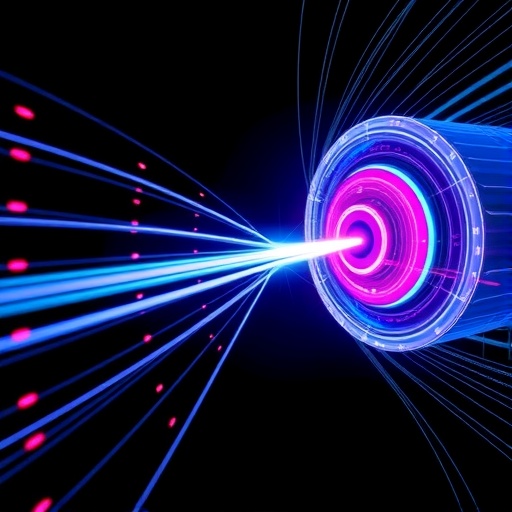In a groundbreaking advancement that redefines our understanding of ultrafast magnetism, researchers have unveiled a dynamic and previously hidden mechanism underpinning the reversal of magnetization in nanoscale magnetic films. This revelation breaks from the long-held assumption of uniform switching across magnetic layers, instead exposing a rapid, propagating domain boundary that sweeps through the material with astonishing speed. Such discoveries not only deepen our comprehension of light-induced magnetic phenomena but also chart a promising path toward next-generation spintronics devices capable of operating at unprecedented speeds.
Ultrafast magnetism—the discipline exploring how brief bursts of light manipulate magnetic states in materials within trillionths of a second—has long captivated physicists and engineers alike. Central to this field is the process known as all-optical switching (AOS), whereby a sub-picosecond laser pulse flips the orientation of tiny magnetic domains without magnetic fields. This capability promises to revolutionize data storage and logic systems, dramatically surpassing the speed and energy efficiency of conventional magnetic read/write technology.
Traditionally, the scientific consensus held that AOS occurs homogeneously wherever a femtosecond laser pulse deposits sufficient energy in a material. This model suggested the magnetic reversal takes place simultaneously throughout the affected region. However, a newly published study by researchers at the Max Born Institute in Berlin, collaborating with groups in Berlin and Nancy, defies this assumption. Utilizing an innovative combination of ultrafast infrared excitation with femtosecond soft X-ray spectroscopy, the team was able to resolve magnetization dynamics not just across the surface, but deep into the 9.4-nanometer-thick gadolinium-cobalt (GdCo) magnetic layer.
Employing broadband soft X-rays finely tuned to the Gd atomic resonance, the scientists devised a novel experimental scheme to probe the temporal evolution of magnetization with slice-by-slice depth resolution. This table-top, femtosecond soft X-ray spectroscopy technique constitutes a significant leap, allowing unprecedented “movie-like” visualization of magnetic domain dynamics inside multilayer heterostructures. The studied sample included a GdCo layer nestled between platinum and copper layers on top and a tantalum layer beneath, replicating the architecture of many spintronic devices.
The results reveal a complex, non-uniform magnetization reversal unfolding over a few picoseconds. Immediately following the arrival of a 27-femtosecond infrared laser pulse, the entire GdCo film experiences nearly homogeneous heating, resulting in a uniform decrease in magnetization. The early phase aligns with previous expectations; however, the subsequent behavior deviates dramatically from prior models.
Approximately two picoseconds post-excitation, a distinct magnetic domain forms at the surface. Energized more intensely due to thermal interactions with the adjacent platinum layer, the surface region flips its magnetization direction first. Meanwhile, the deeper layers remain magnetically unchanged, creating a sharp boundary between oppositely magnetized domains. This boundary is not static—it travels downward through the thickness of the GdCo layer at an extraordinary velocity approaching 2,000 meters per second.
This ultrafast propagating domain boundary completes its traversal of the entire film thickness in around 4.5 picoseconds, effectively “dragging” the magnetization reversal into deeper layers that initially received sub-threshold excitation. This finding challenges the simplistic view of simultaneous switching, illustrating instead a sequential, wavefront-like magnetization inversion emerging from the surface and penetrating into the bulk.
The physical mechanisms driving this moving boundary remain an active area of investigation, but plausible contributors include angular momentum exchange between the reversed and yet-to-be-reversed regions and significant thermal gradients established across the heterostructure on ultrafast time scales. This intricate interplay dictates the velocity and eventual magnetic configuration, underscoring the importance of non-local effects in all-optical switching.
Reconceptualizing AOS as a hybrid process involving both local excitation and non-local boundary propagation forces a significant revision of existent theoretical frameworks, which have largely overlooked such spatially-resolved dynamics. Incorporating these new insights may open avenues for more accurate modeling of laser-driven spin dynamics and the engineering of magnetization reversal pathways in multifunctional magnetic stacks.
Beyond the intellectual breakthrough, these results hold tantalizing practical implications. By judiciously tailoring the composition, thickness, and adjacent layers in magnetic heterostructures, it becomes feasible to engineer the nucleation site and propagation speed of the magnetic domain boundary. This level of control could lead to ultrafast, energy-efficient magnetic memory and logic devices actuated by light pulses instead of electric currents or magnetic fields.
Such spintronic components, leveraging photon-induced magnetization reversal, have the potential to surpass the speed limits of contemporary magnetic storage technology by orders of magnitude. This prospect aligns with the relentless quest in information technology to combine ever-faster operation with low power consumption, critical for sustainable, high-performance computing in the future.
Moreover, the demonstrated capability to spatially and temporally resolve magnetization dynamics through depth represents a powerful diagnostic tool that could be applied to a broad spectrum of magnetic materials and device architectures. The approach pioneered here blends ultrafast optics with advanced X-ray spectroscopies, heralding a new era of nanometer-and-femtosecond precision in magnetism research.
Looking ahead, integration of this precise, depth-resolved control and observation of magnetization processes might foster the development of novel quantum and classical spin-based information processors. The interplay of tailored material engineering and ultrafast optical manipulation lays the foundation for a new generation of technologies bridging fundamental physics and application-driven innovation.
In summary, the discovery of a transient boundary dynamically driving ultrafast magnetization reversal overturns traditional conceptual pictures, revealing a rich physics landscape governing laser-induced spin switching. This advance not only sharpens our scientific understanding but also paves the way for transformative practical advances in spintronics and magnetic data processing, poised to redefine the future of information technology.
Subject of Research: Not applicable
Article Title: Transient domain boundary drives ultrafast magnetisation reversal
News Publication Date: 5-Sep-2025
Web References: http://dx.doi.org/10.1038/s41467-025-63571-3
References: [Nature Communications publication DOI 10.1038/s41467-025-63571-3]
Image Credits: Credits: MBI
Keywords
ultrafast magnetism, all-optical switching, femtosecond lasers, spintronics, gadolinium-cobalt film, magnetic domain boundary, soft X-ray spectroscopy, femtosecond spectroscopy, magnetic heterostructures, magnetization dynamics, angular momentum exchange, thermal gradients
Tags: advancements in data storage technologyall-optical switching mechanismenergy-efficient logic systemsfemtosecond laser pulse technologygroundbreaking research in ultrafast magnetismlight-induced magnetic phenomenamagnetic states manipulationmagnetization reversal dynamicsnanoscale magnetic filmsnext-generation spintronics devicesrapid domain boundary propagationultrafast magnetization switching





